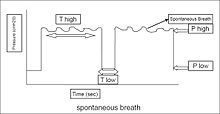Average air pressure in assisted ventilation
Mean airway pressure typically refers to the mean pressure applied during positive-pressure mechanical ventilation . Mean airway pressure correlates with alveolar ventilation, arterial oxygenation,[ 1] hemodynamic performance, and barotrauma .[ 2] [ 3]
Equations
There are several equations aimed at determining the real mean airway pressure.
Volume control ventilation
In ventilation with a square flow waveform this equation can be used:
P
¯
a
w
=
0.5
×
(
P
I
P
−
P
E
E
P
)
×
(
T
I
/
T
t
o
t
)
+
P
E
E
P
{\displaystyle {\bar {P}}_{aw}=0.5\times (PIP-PEEP)\times (T_{I}/T_{tot})+PEEP}
where:
P
¯
a
w
{\displaystyle {\bar {P}}_{aw}}
P
I
P
{\displaystyle PIP}
P
E
E
P
{\displaystyle PEEP}
T
I
{\displaystyle T_{I}}
T
t
o
t
{\displaystyle T_{tot}}
Pressure control ventilation
During pressure control ventilation this variant of the equation can be used:
P
¯
a
w
=
(
P
I
P
−
P
E
E
P
)
×
(
T
I
/
T
t
o
t
)
+
P
E
E
P
{\displaystyle {\bar {P}}_{aw}=(PIP-PEEP)\times (T_{I}/T_{tot})+PEEP}
P
¯
a
w
{\displaystyle {\bar {P}}_{aw}}
P
I
P
{\displaystyle PIP}
P
E
E
P
{\displaystyle PEEP}
T
I
{\displaystyle T_{I}}
T
t
o
t
{\displaystyle T_{tot}}
[ 3]
Airway pressure release ventilation
Variables of APRV schematic In airway pressure release ventilation (APRV) a variation of the previous equation must be used for the variables:
P
¯
a
w
=
(
P
h
i
g
h
×
T
h
i
g
h
)
+
(
P
l
o
w
×
T
l
o
w
)
T
h
i
g
h
+
T
l
o
w
{\displaystyle {\bar {P}}_{aw}={\frac {(P_{high}\times T_{high})\,+(P_{low}\times T_{low})}{T_{high}+T_{low}}}}
where:
P
¯
a
w
{\displaystyle {\bar {P}}_{aw}}
P
h
i
g
h
{\displaystyle {P}_{high}}
P
l
o
w
{\displaystyle {P}_{low}}
T
h
i
g
h
{\displaystyle {T}_{high}}
P
h
i
g
h
{\displaystyle {P}_{high}}
T
l
o
w
{\displaystyle {T}_{low}}
P
l
o
w
{\displaystyle {P}_{low}}
[ 4]
Other equations
M
P
A
W
=
f
×
T
i
60
×
(
P
I
P
−
P
E
E
P
)
+
P
E
E
P
{\displaystyle M_{PAW}={\frac {f\times T_{i}}{60}}\times (P_{IP}-PEEP)+PEEP}
M
P
A
W
=
F
1
F
1
+
F
E
×
P
I
P
+
(
1
−
F
1
F
1
+
F
E
)
×
P
E
E
P
{\displaystyle M_{PAW}={\frac {F_{1}}{F_{1}+F_{E}}}\times P_{IP}+\left(1-{\frac {F_{1}}{F_{1}+F_{E}}}\right)\times PEEP}
M
P
A
W
=
(
R
)
(
T
i
)
(
P
I
)
+
[
60
−
(
R
)
(
T
i
)
]
(
P
E
E
P
)
60
{\displaystyle M_{PAW}={\frac {(R)(T_{i})(P_{I})+[60-(R)(T_{i})](PEEP)}{60}}}
M
P
A
W
=
f
×
T
i
60
×
(
P
I
P
−
P
E
E
P
)
+
P
E
E
P
{\displaystyle M_{PAW}={\frac {f\times T_{i}}{60}}\times (P_{IP}-PEEP)+PEEP}
[ 5]
M
P
A
W
=
(
T
i
×
P
I
P
)
+
(
T
e
×
P
E
E
P
)
T
i
+
T
e
{\displaystyle M_{PAW}={\frac {(T_{i}\times P_{IP})+(T_{e}\times PEEP)}{T_{i}+T_{e}}}}
Clinical significance
Mean airway pressure has been shown to have a similar correlation as plateau pressure to mortality.[ 6]
MAP is closely associated with mean alveolar pressure and shows the stresses exerted on the lung parenchyma on mechanical ventilation.[ 7]
In high frequency oscillatory ventilation , it has been suggested to set the mean airway pressure six above the lower inflection point on the lungs P-V curve.[ 8]
See also
References
^ Stewart AR, Finer NN, Peters KL (1981). "Effects of alterations of inspiratory and expiratory pressures and inspiratory/expiratory ratios on mean airway pressure, blood gases, and intracranial pressure". Pediatrics . 67 (4): 474– 81. doi :10.1542/peds.67.4.474 . PMID 6789294 . S2CID 2214900 . ^ Marini JJ, Ravenscraft SA (1992). "Mean airway pressure: physiologic determinants and clinical importance--Part 2: Clinical implications". Crit Care Med . 20 (11): 1604– 16. doi :10.1097/00003246-199211000-00020 . PMID 1424706 . S2CID 42496727 . ^ a b Hess, Dean (October 21, 2014). "Respiratory Mechanics in Mechanically Ventilated Patients" (PDF) . Respiratory Care . 59 (11): 1773– 1794. doi :10.4187/respcare.03410 . PMID 25336536 . S2CID 5706765 . Archived (PDF) from the original on July 9, 2022. Retrieved May 27, 2022 . ^ Daoud, Ehab G. (2007). "Airway pressure release ventilation" . Annals of Thoracic Medicine . 2 (4): 176– 179. doi :10.4103/1817-1737.36556 ISSN 1817-1737 . PMC 2732103 PMID 19727373 . ^ David W. Chang (1999). Respiratory care calculations ISBN 978-0-7668-0517-0 . Retrieved 30 March 2012 . ^ Sahetya, Sarina; Wu, David; Brooks, Morgan (May 2020). "Mean Airway Pressure As a Predictor of 90-Day Mortality in Mechanically Ventilated Patients" . Critical Care Medicine . 48 (5): 688– 695. doi :10.1097/CCM.0000000000004268 . PMC 8273919 PMID 32079893 . ^ Su, Longxiang; Pan, Pan; Liu, Dawei; Long, Yun (2021-10-01). "Mean airway pressure has the potential to become the core pressure indicator of mechanical ventilation: Raising to the front from behind the clinical scenes" . Journal of Intensive Medicine . 1 (2): 96– 98. doi :10.1016/j.jointm.2021.04.002 ISSN 2667-100X . PMC 9923962 PMID 36788801 . S2CID 236575021 . ^ Goddon, Sven; Fujino, Yuji; Hromi, Jonathan M.; Kacmarek, Robert M. (May 2001). "Optimal Mean Airway Pressure during High-frequency Oscillation: Predicted by the Pressure–Volume Curve" . Anesthesiology . 94 (5): 862– 869. doi :10.1097/00000542-200105000-00026 ISSN 0003-3022 . PMID 11388539 . S2CID 9604584 .















}{60}}}](https://wikimedia.org/api/rest_v1/media/math/render/svg/c386d4e8bc294a8206393853507d118b5ef8f1c9)
